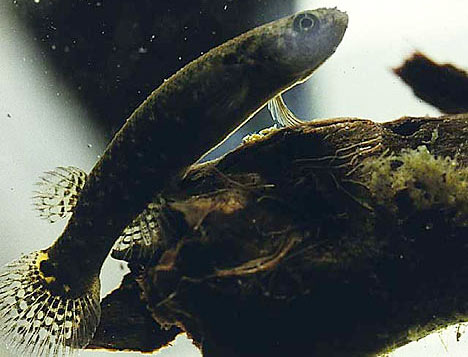There is a fish that lives on ... trees
Because of 'living' life, larvae fish can temporarily change their biological structure to adapt to life on the branches. Instead of soaking in water, this particular fish . breathes air and hunts continuously for months.
With the scientific name Rivulus marmoratus Poey , larvae hunting fish parasites on mangrove stems have been awarded the title of the most exotic fish that humans have ever known. In addition to being able to live on trees, Poey fish also has another " natural" ability to lay babies without mating.
This extraordinary capable fish was discovered by biologists on a field trip through the swamps in Belize and Florida - where they found hundreds of long-spotted fish by burning fingers in the branches. and rotten tree trunk. Inside the stalks, they lie in tandem along the ' trails ' that the insects have previously chiseled.
Anyway, living in a tree is not as comfortable as in a lake, if not extremely suffocating and crowded. Poey fish, known for its clear territorial division - must have tried very hard to contain the wrath.

Poey fish can breathe in the air.(Photo: Thisislondon.co.uk)
An equally important question is, how did the fish transform their body's metabolism and structure to adapt to the new environment?
According to an analysis from researchers, bringing Poey fish has been ' upgraded ' to concurrently function as a water and nutrient holder, the remaining wastes will be excreted through the skin. More specifically, this change is only temporary. The natural structure is returned to its original form after the fish return to the water environment.
Previously, Poey fish was famous for being the only vertebrate that could reproduce without a partner. In other words, they develop both male and female genitals, which are responsible for fertilizing eggs right inside your body.
In terms of the ability to breathe air, Poey also has another 'ally' that is a walking catfish in Southeast Asia - its bearing allows breathing underwater and on land.
And the Indian perch is going to suffocate if you don't regularly throw yourself out of the water to get the air.
Hai Minh
- Strange fish 'hate water' likes to run and climb trees!
- Video: Watch fish archers 'shoot' prey on trees
- 'The strange fish' lives 'super life' despite being locked up
- Fish robots rescue ocean fish
- Humans account for 0.01% of life and ... erase other lives
- The special body of fish lives at a depth of 8,178 meters
- Things you do not know about marine fish statues
- Discovered a new porcupine that lives on trees in Brazil
- Strange stories about traces of reincarnation (2)
- Fish live on land
- Sharp-toothed lancets are washed up
- The 90-year-old lung fish lives through 13 generations of the US president just 'died'.
 Animal 'suffering' after hibernation
Animal 'suffering' after hibernation Why do goats climb well?
Why do goats climb well? Scientists were surprised to see chimpanzees eating turtles
Scientists were surprised to see chimpanzees eating turtles Giant catfish died deadly due to drought in Thailand
Giant catfish died deadly due to drought in Thailand A deep hole appeared in a fish pond, 20,000 fish disappeared overnight in China
A deep hole appeared in a fish pond, 20,000 fish disappeared overnight in China  Strange species in Southeast Asia becomes the first marine fish species 'extinct due to humans'
Strange species in Southeast Asia becomes the first marine fish species 'extinct due to humans'  What time of day is the easiest to fish?
What time of day is the easiest to fish?  Special uses of a highly poisonous plant that grows throughout Vietnam
Special uses of a highly poisonous plant that grows throughout Vietnam  Why are there so many giant fish flooding the Three Gorges Dam but no one dares to catch them?
Why are there so many giant fish flooding the Three Gorges Dam but no one dares to catch them?  Specialty fish 'vong bat lieu ngu' is more expensive than gold but still sought after
Specialty fish 'vong bat lieu ngu' is more expensive than gold but still sought after 